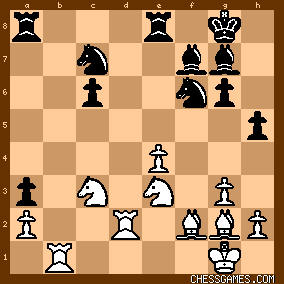| Mar-13-07 | | beatles fan: Just played through this game with Mr. Bronstein's book and a chessboard for variations. Brilliant!!! I love Averbakh's system (Rf1-f2) (Rf2-d2) after caslting, to put more pressure on the weak d-pawn. |
|
| Jul-10-09 | | ozmikey: A fascinating game throughout, and Bronstein's notes are indeed magnificent. In the line that he gives after Black's 25th (26. fxg6! fxg6 27. e5 Rxe5 28. Qxg6), I wonder whether Black can defend successfully by 28...Re6? |
|
Sep-03-12
 | | Peligroso Patzer: Najdorf in <Zürich 1953: 15 Contenders for the World Chess Championship>, by NAJDORF, Miguel, tr. by Kingston, Taylor, Russell Enterprises, Inc. ©2012, at p. 87, gives <33. Rb7> the annotation “?” in the following position: 
click for larger view
His obscure (at least to me) comment is: “Pressed for time, Averbakh loses the thread. 33. Bf1 was essential, with good drawing chances since White’s weakness at e4 is counterbalanced by Black’s at c6.” I really don’t see the point of <33. Bf1>, and FWIW, neither does Fritz rate it highly. |
|
| May-07-16 | | Ulhumbrus: <Peligroso Patzer: Najdorf in <Zürich 1953: 15 Contenders for the World Chess Championship>, by NAJDORF, Miguel, tr. by Kingston, Taylor, Russell Enterprises, Inc. ©2012, at p. 87, gives <33. Rb7> the annotation “?” in the following position: click for larger view
His obscure (at least to me) comment is: “Pressed for time, Averbakh loses the thread. 33. Bf1 was essential, with good drawing chances since White’s weakness at e4 is counterbalanced by Black’s at c6.” I really don’t see the point of <33. Bf1>, and FWIW, neither does Fritz rate it highly.> After 33 Bf1 suppose that Black takes the e4 pawn by 33...Rxe4. Then 34 Bg2 skewers Black's rook on e4 to Black's pawn on c6. Thus this potential skewer serves to keep White's e4 pawn alive. The move 34...Na6 would be prevented by a bishop on f1 and this suggests that 33 Bf1 serves partly to prevent the move ...Na6. From a6 the knight can go to c5 attacking again White's e4 pawn. |
|
|
|
|





